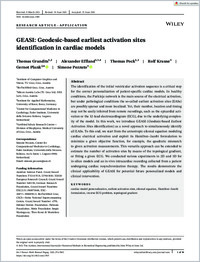GEASI : Geodesic-based earliest activation sites identification in cardiac models
- Grandits, Thomas Institute of Computer Graphics and Vision, TU Graz, Graz, Austria - BioTechMed-Graz, Graz, Austria
- Effland, Alexander Institute of Computer Graphics and Vision, TU Graz, Graz, Austria - Silicon Austria Labs (TU Graz SAL DES Lab), Graz, Austria - Institute for Applied Mathematics, University of Bonn, Bonn, Germany
- Pock, Thomas Institute of Computer Graphics and Vision, TU Graz, Graz, Austria - BioTechMed-Graz, Graz, Austria
- Krause, Rolf Center for Computational Medicine in Cardiology, Euler Institute (EUL), Università della Svizzera italiana, Switzerland
- Plank, Gernot BioTechMed-Graz, Graz, Austria - Gottfried Schatz Research Center-Division of Biophysics, Medical University of Graz, Graz, Austria
- Pezzuto, Simone Center for Computational Medicine in Cardiology, Euler Institute (EUL), Università della Svizzera italiana, Switzerland
-
25.06.2021
Published in:
- International journal for numerical methods in biomedical engineering. - Wiley. - 2021, vol. 37, no. 8, p. 30
Cardiac model personalization
Earliest activation sites
Eikonal equation : Hamilton–Jacobi
Formulation
Inverse ECG problem
Topological gradient
English
The identification of the initial ventricular activation sequence is a critical step for the correct personalization of patient- specific cardiac models. In healthy conditions, the Purkinje network is the main source of the electrical activation, but under pathological conditions the so-called earliest activation sites (EASs) are possibly sparser and more localized. Yet, their number, location and timing may not be easily inferred from remote recordings, such as the epicardial activation or the 12-lead electrocardiogram (ECG), due to the underlying complexity of the model. In this work, we introduce GEASI (Geodesic-based Earliest Activation Sites Identification) as a novel approach to simultaneously identify all EASs. To this end, we start from the anisotropic eikonal equation modeling cardiac electrical activation and exploit its Hamilton–Jacobi formulation to minimize a given objective function, for example, the quadratic mismatch to given activation measurements. This versatile approach can be extended to estimate the number of activation sites by means of the topological gradient, or fitting a given ECG. We conducted various experiments in 2D and 3D for in-silico models and an in-vivo intracardiac recording collected from a patient undergoing cardiac resynchronization therapy. The results demonstrate the clinical applicability of GEASI for potential future personalized models and clinical intervention.
- Collections
- Language
-
- English
- Classification
- Medicine
- License
- Open access status
- hybrid
- Identifiers
-
- RERO DOC 333693
- DOI 10.1002/cnm.3505
- ARK ark:/12658/srd1319302
- Persistent URL
- https://n2t.net/ark:/12658/srd1319302
Statistics
Document views: 260
File downloads:
- Texte intégral: 409
